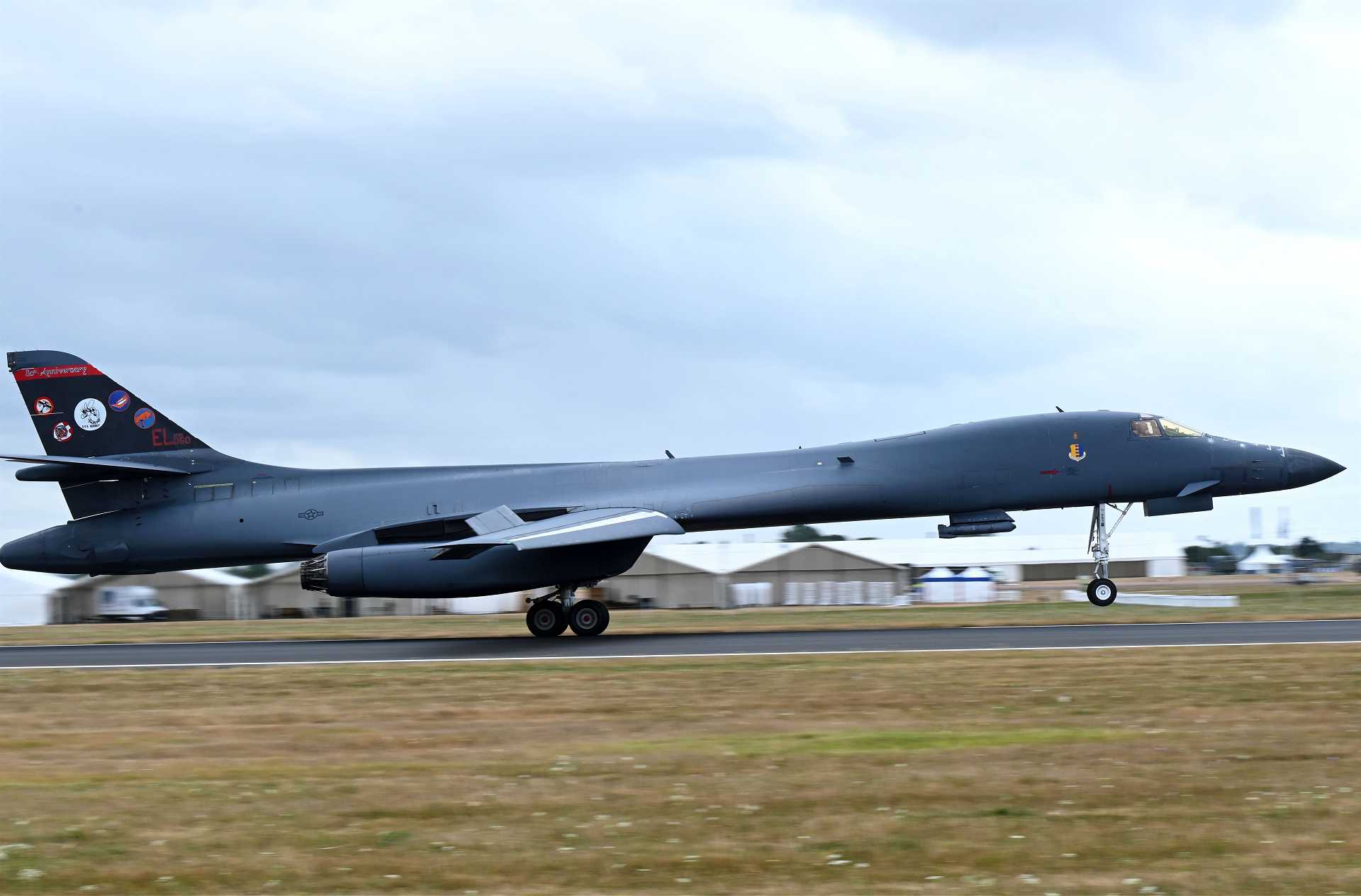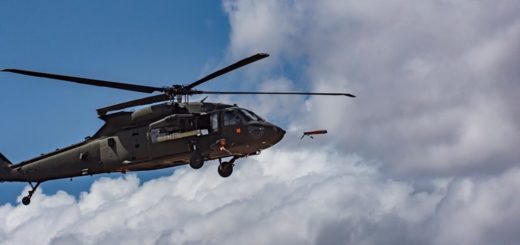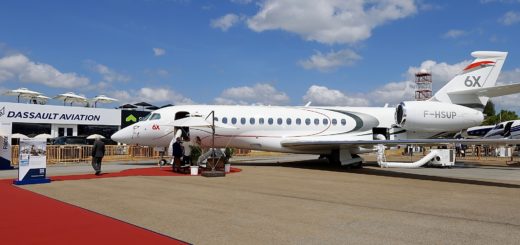RIAT 2025: U.S. Air Force B-1B Lancer Strategic Bomber Displayed in Rare European Appearance

{loadposition bannertop}
{loadposition sidebarpub}
A U.S. Air Force B-1B Lancer bomber from the 37th Bomb Squadron, Ellsworth Air Force Base, South Dakota, landed at Royal Air Force Fairford, England, on July 15, 2025, to participate in the Royal International Air Tattoo (RIAT), taking place from July 18 to 20, 2025. As one of the most advanced long-range bombers in the world, the B-1B is being featured in a static display as part of the U.S. military’s contribution to the show, reflecting its vital role in U.S. global strike doctrine and transatlantic defense cooperation. Its rare public appearance in Europe is both a strategic signal and a demonstration of U.S. airpower readiness in support of NATO deterrence objectives.Follow Army Recognition on Google News at this link
A U.S. Air Force B-1B Lancer from the 37th Bomb Squadron, Ellsworth Air Force Base, South Dakota, lands at RAF Fairford, England, on July 15, 2025, ahead of its participation in the Royal International Air Tattoo. (Picture source: U.S. DoD)
The B-1B Lancer is a high-speed, long-range strategic bomber designed to deliver large volumes of conventional munitions over intercontinental distances. Powered by four General Electric F101-GE-102 afterburning turbofan engines, the aircraft can reach speeds of Mach 1.25 at high altitude and fly unrefueled for more than 7,400 kilometers, with in-flight refueling extending its global reach. One of its most distinctive features is its variable-geometry wing design, which allows it to sweep its wings for optimal performance at both low-level penetration and high-speed cruise. The B-1B can carry up to 24 AGM-158 Joint Air-to-Surface Standoff Missiles (JASSMs), 84 Mk-82 500-lb bombs, or a mix of precision-guided and unguided munitions, giving it unmatched flexibility in strike operations.
In terms of combat roles and capabilities, the B-1B is optimized for rapid response, theater-wide strikes, and deep interdiction missions in contested environments. Its combination of speed, stealth features (such as reduced radar cross-section), and high survivability allows it to penetrate advanced air defense systems and deliver precision strikes with minimal warning. Unlike the B-52 and B-2, the B-1B is not constrained by international arms treaties limiting nuclear payloads, enabling it to be fully dedicated to conventional warfare. This allows the platform to serve as a cornerstone of conventional deterrence and power projection, particularly during crisis response or high-intensity conflict scenarios. Its large weapons bay and advanced defensive avionics suite make it suitable for both first-strike and sustained air campaign roles.
In the European theater, the B-1B’s presence holds strategic significance. As part of the U.S. Bomber Task Force (BTF) deployments, B-1Bs have routinely operated from RAF Fairford and other NATO airfields, conducting missions across the High North, Baltic Sea, Black Sea, and Eastern Europe. These flights enhance interoperability with allied air forces and demonstrate the United States’ ability to rapidly surge long-range strike assets in support of NATO deterrence. In recent years, B-1Bs have participated in joint exercises such as Arctic Challenge, Point Blank, and Baltic Operations, where they practiced long-range maritime interdiction, precision strikes, and integration with fifth-generation fighters. Their operations serve as a visible and credible deterrent against potential adversaries, including Russian military provocations on NATO’s eastern flank.
Operationally, the B-1B continues to play a critical role in U.S. global military operations. In 2024, B-1B bombers were involved in long-range strike missions in the Middle East in response to escalating threats from Iranian-aligned militias, delivering precision-guided munitions against command and logistics nodes with minimal collateral damage. The aircraft also supported Indo-Pacific Command objectives through rotational deployments to Andersen Air Force Base, Guam, conducting Bomber Assurance and Deterrence (BAAD) patrols in response to Chinese military maneuvers near Taiwan and the South China Sea. Its rapid global deployment capability and precision strike effectiveness make the B-1B an indispensable asset in the evolving strategic landscape, where long-range and survivable firepower is increasingly critical to deterrence and conflict resolution.
By displaying the B-1B Lancer at RIAT 2025, the U.S. Air Force not only reinforces its commitment to NATO and European security but also provides defense audiences with a firsthand look at one of the most versatile and capable platforms in the USAF arsenal. As NATO continues to adapt to a more complex and contested security environment, the strategic presence of the B-1B serves as a powerful reminder of allied resolve and the operational capabilities that underpin collective defense.

{loadposition bannertop}
{loadposition sidebarpub}
A U.S. Air Force B-1B Lancer bomber from the 37th Bomb Squadron, Ellsworth Air Force Base, South Dakota, landed at Royal Air Force Fairford, England, on July 15, 2025, to participate in the Royal International Air Tattoo (RIAT), taking place from July 18 to 20, 2025. As one of the most advanced long-range bombers in the world, the B-1B is being featured in a static display as part of the U.S. military’s contribution to the show, reflecting its vital role in U.S. global strike doctrine and transatlantic defense cooperation. Its rare public appearance in Europe is both a strategic signal and a demonstration of U.S. airpower readiness in support of NATO deterrence objectives.
Follow Army Recognition on Google News at this link
A U.S. Air Force B-1B Lancer from the 37th Bomb Squadron, Ellsworth Air Force Base, South Dakota, lands at RAF Fairford, England, on July 15, 2025, ahead of its participation in the Royal International Air Tattoo. (Picture source: U.S. DoD)
The B-1B Lancer is a high-speed, long-range strategic bomber designed to deliver large volumes of conventional munitions over intercontinental distances. Powered by four General Electric F101-GE-102 afterburning turbofan engines, the aircraft can reach speeds of Mach 1.25 at high altitude and fly unrefueled for more than 7,400 kilometers, with in-flight refueling extending its global reach. One of its most distinctive features is its variable-geometry wing design, which allows it to sweep its wings for optimal performance at both low-level penetration and high-speed cruise. The B-1B can carry up to 24 AGM-158 Joint Air-to-Surface Standoff Missiles (JASSMs), 84 Mk-82 500-lb bombs, or a mix of precision-guided and unguided munitions, giving it unmatched flexibility in strike operations.
In terms of combat roles and capabilities, the B-1B is optimized for rapid response, theater-wide strikes, and deep interdiction missions in contested environments. Its combination of speed, stealth features (such as reduced radar cross-section), and high survivability allows it to penetrate advanced air defense systems and deliver precision strikes with minimal warning. Unlike the B-52 and B-2, the B-1B is not constrained by international arms treaties limiting nuclear payloads, enabling it to be fully dedicated to conventional warfare. This allows the platform to serve as a cornerstone of conventional deterrence and power projection, particularly during crisis response or high-intensity conflict scenarios. Its large weapons bay and advanced defensive avionics suite make it suitable for both first-strike and sustained air campaign roles.
In the European theater, the B-1B’s presence holds strategic significance. As part of the U.S. Bomber Task Force (BTF) deployments, B-1Bs have routinely operated from RAF Fairford and other NATO airfields, conducting missions across the High North, Baltic Sea, Black Sea, and Eastern Europe. These flights enhance interoperability with allied air forces and demonstrate the United States’ ability to rapidly surge long-range strike assets in support of NATO deterrence. In recent years, B-1Bs have participated in joint exercises such as Arctic Challenge, Point Blank, and Baltic Operations, where they practiced long-range maritime interdiction, precision strikes, and integration with fifth-generation fighters. Their operations serve as a visible and credible deterrent against potential adversaries, including Russian military provocations on NATO’s eastern flank.
Operationally, the B-1B continues to play a critical role in U.S. global military operations. In 2024, B-1B bombers were involved in long-range strike missions in the Middle East in response to escalating threats from Iranian-aligned militias, delivering precision-guided munitions against command and logistics nodes with minimal collateral damage. The aircraft also supported Indo-Pacific Command objectives through rotational deployments to Andersen Air Force Base, Guam, conducting Bomber Assurance and Deterrence (BAAD) patrols in response to Chinese military maneuvers near Taiwan and the South China Sea. Its rapid global deployment capability and precision strike effectiveness make the B-1B an indispensable asset in the evolving strategic landscape, where long-range and survivable firepower is increasingly critical to deterrence and conflict resolution.
By displaying the B-1B Lancer at RIAT 2025, the U.S. Air Force not only reinforces its commitment to NATO and European security but also provides defense audiences with a firsthand look at one of the most versatile and capable platforms in the USAF arsenal. As NATO continues to adapt to a more complex and contested security environment, the strategic presence of the B-1B serves as a powerful reminder of allied resolve and the operational capabilities that underpin collective defense.






